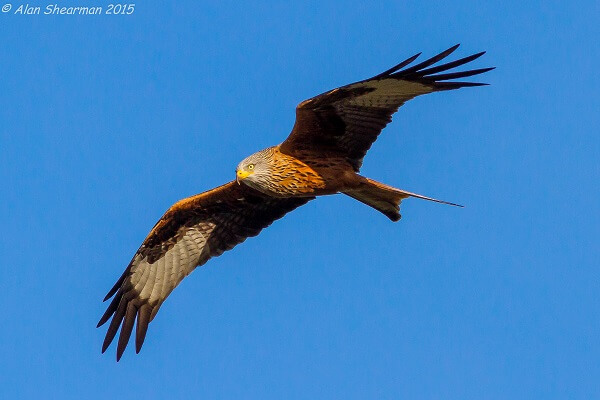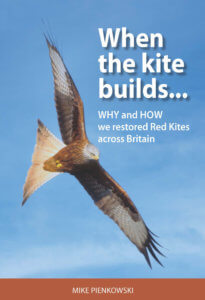New Book to be Published on Reintroduction of Red Kites

A new book will be published on the reintroduction of red kites, ‘the biggest species success in UK conservation history’, for UN World Wildlife Day on 3 March.
The book describes the story of the successful reintroduction of red kites to the UK in 1990s. It details how the Chilterns was selected as the initial location for the establishment of young chicks brought in from Sweden and Spain. The book’s author, Dr Mike Pienkowski, was the Chairman of the Red Kite Project Team from the 1980s to 1995.
In the Middle Ages, Red Kites were a common sight across the British countryside and cities, where people valued them for keeping the streets clear of carrion (dead animals). The birds were frequently mentioned in Shakespeare’s works. But later changes in attitude led to their extermination in most of the UK, until they were reduced to a tiny population in Wales. By the 1980s, they were one of only three globally vulnerable bird species occurring in Britain.
Following the success of their reintroduction, red kites are now one of the iconic sights of the Chilterns and many other parts of Britain and Ireland, valued as part of the landscape. British kites now form 10% of the world population of the species.
The book, When the Kite Builds: Why and how we restored red kites across Britain:
- Describes why the decision was taken to reintroduce the kites and how international help was needed to find a healthy source of red kite chicks, with the first imported kites coming from Sweden and Spain.
- Examines the success of the experiment.
- Explores the challenges of collecting and transporting the red kite chicks, and how help was enlisted from the RAF and British Airways.
- Describes how Wormsley in the Chilterns was selected as a safe place for rearing the young kites in quarantine conditions, with minimal human contact.
- Explores the outcome for red kites and other species, the fight against illegal persecution and poisoning, and the changes in public attitudes.
In 2020, looking back over more than 30 years, RSPB described the Red Kite project as ‘the biggest species success story in UK conservation history’, noting also: ‘The Red Kite introduction project has been a fantastic example of conservation in action and is the result of really effective partnership working, which we’re proud to be part of. It’s been amazing to see a species once persecuted to near extinction in this country, brought back and welcomed by local communities, with local economies reaping the dividends of the return of this iconic species. In the 1980s, anyone wanting to see a Red Kite had to make a special pilgrimage to a handful of sites. Today it is a daily sight for millions of people. In a few short decades we have taken a species from the brink of extinction to the UK being home to almost 10% of the entire world population.’
 The book’s publication coincides with UN World Wildlife Day on 3 March. This year, the theme has changed from ‘Recovering key species for ecosystem restoration’ to ‘Partnerships for Wildlife Conservation’. The Red Kite Project involved a huge range of scientists and conservationists, overseas colleagues, farmers, game-keepers, land-owners, commercial organisations, the armed forces, local and national governments and volunteers.
The book’s publication coincides with UN World Wildlife Day on 3 March. This year, the theme has changed from ‘Recovering key species for ecosystem restoration’ to ‘Partnerships for Wildlife Conservation’. The Red Kite Project involved a huge range of scientists and conservationists, overseas colleagues, farmers, game-keepers, land-owners, commercial organisations, the armed forces, local and national governments and volunteers.
Dr Mike Pienkowski (the book’s author and chairman of the original experimental project) said: ‘I am delighted to get this book out. It is important to put such successes on record – I hope in a readable way. This is both to help others and to recognise the teamwork of a huge number of people in UK and other countries.’
Dr Elaine King, CEO of the Chilterns Conservation Board said: ’40 years ago, red kites were never seen in the Chilterns. Today, these magnificent birds are one of the most iconic sights associated with the area, soaring high over the fields, villages and gardens, riding the thermals with that characteristic flick of their forked tails. The bird is often named and used as an emblem for local buildings and businesses and has become recognised as a valuable and much-loved part of the Chilterns landscape. Our hope is that red kites will remain appreciated and valued, living in their natural habitat in the Chilterns. We’re immensely proud that the Chilterns Area of Outstanding Natural Beauty has been part of such an incredible conservation success story.’
English Nature’s Chairman, Tony Juniper, said ‘Thanks to this pioneering reintroduction programme in the Chilterns, increased legal protection and collaboration amongst partners, the Red Kite stands out as a true conservation success story. The flagship Red Kite reintroduction project paved the way for further species re-introductions, helping to reverse the historic deterioration of our natural environment and our precious species that inhabit it.’

